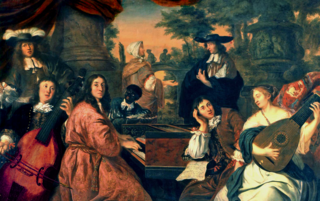
Johann Adam Reincken was a Dutch/German organist and composer. He was one of the most important composers of the 17th century, a friend of Dieterich Buxtehude and a major influence on Johann Sebastian Bach; however, very few of his works survive to this day.
This is a list of notable events in music that took place in the year 1735.

A pedalboard is a keyboard played with the feet that is usually used to produce the low-pitched bass line of a piece of music. A pedalboard has long, narrow lever-style keys laid out in the same semitone scalar pattern as a manual keyboard, with longer keys for C, D, E, F, G, A, and B, and shorter, raised keys for C♯, D♯, F♯, G♯ and A♯. Training in pedal technique is part of standard organ pedagogy in church music and art music.

The organ of the St. Jacobi Church in Hamburg, was built from 1689 to 1693 by the most renowned organ builder of his time, Arp Schnitger. The organ boasts four manuals and pedal with 60 stops, 15 of which are reeds – and has approximately 4000 sounding pipes. All in all, from the organ's original installation and its condition today not much of its conception has changed. The old pipework and the prospect pipes have been preserved in almost original format. It is the largest organ in existence from before 1700 and is one of the most eminent Baroque instruments that have been preserved.
Wolfgang Friedrich Rübsam is a German-American organist, pianist, composer and pedagogue.
The 17th century organ composers of Germany can be divided into two primary schools: the north German school and the south German school. The stylistic differences were dictated not only by teacher-pupil traditions and international influences, but also by separate organ building traditions: northern organs tend to have a tower layout with emphasis on the pedal division, while southern and Austrian instruments are typically divided around a window and emphasize manual divisions.

Johann Sebastian Bach was a German composer and musician of the late Baroque period. He is known for his prolific output across a variety of instruments and forms, including the orchestral Brandenburg Concertos; solo instrumental works such as the cello suites and sonatas and partitas for solo violin; keyboard works such as the Goldberg Variations and The Well-Tempered Clavier; organ works such as the Schubler Chorales and the Toccata and Fugue in D minor; and choral works such as the St Matthew Passion and the Mass in B minor. Since the 19th-century Bach Revival, he has been widely regarded as one of the greatest composers in the history of Western music.

Harald Vogel is a German organist, organologist, and author. He is a leading expert on Renaissance and Baroque keyboard music. He has been professor of organ at the University of the Arts Bremen since 1994.
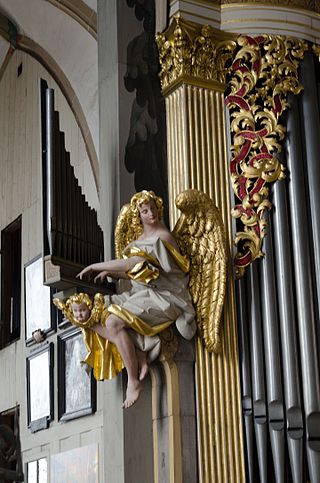
Prelude and Fugue in A minor, BWV 543 is a piece of organ music written by Johann Sebastian Bach sometime around his years as court organist to the Duke of Saxe-Weimar (1708–1713).

The Great Eighteen Chorale Preludes, BWV 651–668, are a set of chorale preludes for organ prepared by Johann Sebastian Bach in Leipzig in his final decade (1740–1750), from earlier works composed in Weimar, where he was court organist. The works form an encyclopedic collection of large-scale chorale preludes, in a variety of styles harking back to the previous century, that Bach gradually perfected during his career. Together with the Orgelbüchlein, the Schübler Chorales, the third book of the Clavier-Übung and the Canonic Variations, they represent the summit of Bach's sacred music for solo organ.

The Great Fantasia and Fugue in G minor, BWV 542, is an organ prelude and fugue by Johann Sebastian Bach. It acquired that name to distinguish it from the earlier Little Fugue in G minor, which is shorter. This piece is not to be confused with the Prelude and Fugue in A minor, which is also for organ and also sometimes called "the Great".
Rudolf Kelber is a German organist, harpsichordist, conductor and church musician.

Wo Gott der Herr nicht bei uns hält is a chorale fantasia for organ composed by Johann Sebastian Bach, likely between 1705 and 1710. The Zahn 4441a hymn tune for Justus Jonas's 1524 hymn "Wo Gott der Herr nicht bei uns hält", a paraphrase of Psalm 124, is the basis of the composition.

St Egidien on Egidienplatz is the former Benedictine Abbey of Saint Giles (Egidienskirche), now a church in the former free imperial city of Nuremberg, southern Germany. It is considered a significant contribution to the baroque church architecture of Middle Franconia.
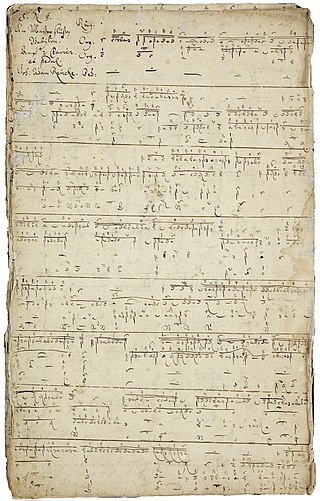
An Wasserflüssen Babylon is a chorale fantasia for organ by Johann Adam Reincken, based on "An Wasserflüssen Babylon", a 16th-century Lutheran hymn by Wolfgang Dachstein. Reincken likely composed the fantasia in 1663, partly as a tribute to Heinrich Scheidemann, his tutor and predecessor as organist at St. Catherine's Church, Hamburg. With its 327 bars, it is the most extended repertoire piece of this kind. Reincken's setting is a significant representative of the north German style of organ music.
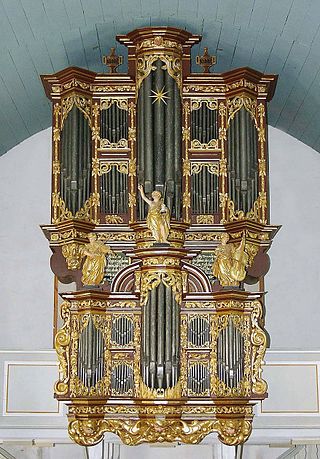
The organ of St. Peter and Paul in Cappel was built in 1680 by Arp Schnitger for the St. Johannis-Klosterkirche in Hamburg and has been in Cappel, Lower Saxony since 1816. It is considered to be the most complete and sonically best-preserved organ from the late 17th century in northern Germany. The instrument has two manuals with pedal and 30 stops, of which only two are not entirely old. Helmut Walcha's recordings of Bach's organ works (1950–1952) made this instrument world-famous.

The organ of St. Ludgeri in Norden was built from 1686 to 1692 by Arp Schnitger. It has 46 stops, five divisions, three manuals and pedal, and is thus the second-largest surviving Schnitger organ in Germany and until 2018 the largest organ in East Frisia. Historically and musically it is considered an art-work of international rank.
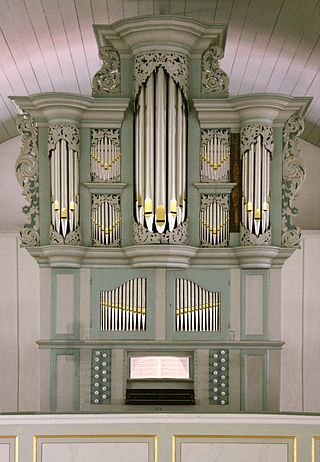
The organ of the Grasberg church, or Findorffkirche, in Grasberg was built in 1693–1694 by Arp Schnitger, originally for the orphanage at Rödingsmarkt in Hamburg, and transferred to Grasberg in 1788. It is one of the few instruments by Schnitger to have been structurally changed as early as the 18th century. The organ has 21 stops, over two manuals and pedal. 15 stops are still original Schnitger work.
The Organ is complete. See P.21 in the November/December issue of "Choir and Organ." Vol. 21, No. 6. Published by Rheingold Publishing, 20 Rugby Street, LondonWC1N 3QZ UK.














